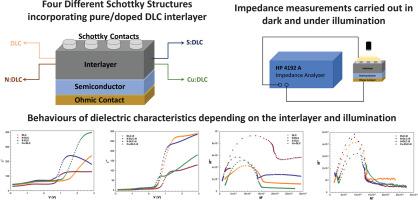从高介电层(纯、N、S、Cu掺杂DLC)和光曝光的角度对肖特基二极管的介电特性进行比较分析
IF 5.1
3区 材料科学
Q2 MATERIALS SCIENCE, COATINGS & FILMS
引用次数: 0
摘要
本研究主要旨在阐明肖特基二极管(SDs)中不同中间层对其介电性能的影响。本研究的另一个目的是揭示相关介电性质随光照的变化。为此,通过电化学沉积方法制备了4种包含DLC、N-DLC、S-DLC和Cu-DLC中间层的SDs,并在环境温度和1 MHz频率值下进行了阻抗测量。之后,在100mw /cm2的照明强度下重复测量。计算得到的ε′、ε″和tanδ值在衰竭区和富集区均表现出层间依赖性变化。在M*分析中,M′-V图表现为逐渐下降,在耗尽区急剧下降,而M″-V图在同一电压范围内表现为明显的峰值,对应于弛豫过程。另一方面,M″-M′图证实了一个单一的松弛过程,其弧半径随层间类型的不同而变化。具有S-DLC中间层的SD具有最高的σac电导率,相位角值代表了各中间层的电容特性。电介质数据表明,光照在耗尽区和积累区都是有效的。值得注意的是,含有DLC和Cu-DLC中间层的SDs具有最高的照明灵敏度。总体而言,与传统SiO2相比,所有SDs的ε′值都明显较高,表明其电荷和能量存储能力增强,强调了将DLC作为SDs中间层的独创性和潜力,无论是掺杂还是未掺杂。本文章由计算机程序翻译,如有差异,请以英文原文为准。

Comparative dielectric analysis of Schottky diodes from the perspective of the high-dielectric interlayers (pure, N, S, Cu doped DLC) and light exposure
This study primarily aims to elucidate the impact of different interlayers employed in Schottky diodes (SDs) on their dielectric properties. A further aim of this study is to reveal the variation in the relevant dielectric properties with illumination. To this end, four SDs incorporating DLC, N-DLC, S-DLC, and Cu-DLC interlayers were produced via the electrochemical deposition method, and their impedance measurements were performed at ambient temperature and 1 MHz frequency value. Afterwards, the measurements were repeated under an illumination intensity of 100 mW/cm2. The computed , and tanδ values exhibit interlayer-dependent variations in both the depletion and accumulation regions. In the M* analysis, the M′–V plots show a gradual decrease, with a sharp decline in the depletion region, while the M″–V plots display a distinct peak in the same voltage range, corresponding to the relaxation process. On the other hand, the M″–M′ plots confirm a single relaxation process, with the arc radius varying depending on the interlayer type. Additionally, the SD with S-DLC interlayer exhibits the highest conductivity, while phase angle values represent the capacitive traits of all the interlayers. Dielectric data indicate that illumination becomes effective in both depletion and accumulation regions. Notably, SDs incorporating DLC and Cu-DLC interlayers exhibit the highest illumination sensitivity. Overall, the noticeably high values of all SDs, compared to the conventional SiO2, indicate an enhanced capacity for charge and energy storage, emphasizing the originality and potential of employing DLC, whether doped or undoped, as an interlayer in SDs.
求助全文
通过发布文献求助,成功后即可免费获取论文全文。
去求助
来源期刊

Diamond and Related Materials
工程技术-材料科学:综合
CiteScore
6.00
自引率
14.60%
发文量
702
审稿时长
2.1 months
期刊介绍:
DRM is a leading international journal that publishes new fundamental and applied research on all forms of diamond, the integration of diamond with other advanced materials and development of technologies exploiting diamond. The synthesis, characterization and processing of single crystal diamond, polycrystalline films, nanodiamond powders and heterostructures with other advanced materials are encouraged topics for technical and review articles. In addition to diamond, the journal publishes manuscripts on the synthesis, characterization and application of other related materials including diamond-like carbons, carbon nanotubes, graphene, and boron and carbon nitrides. Articles are sought on the chemical functionalization of diamond and related materials as well as their use in electrochemistry, energy storage and conversion, chemical and biological sensing, imaging, thermal management, photonic and quantum applications, electron emission and electronic devices.
The International Conference on Diamond and Carbon Materials has evolved into the largest and most well attended forum in the field of diamond, providing a forum to showcase the latest results in the science and technology of diamond and other carbon materials such as carbon nanotubes, graphene, and diamond-like carbon. Run annually in association with Diamond and Related Materials the conference provides junior and established researchers the opportunity to exchange the latest results ranging from fundamental physical and chemical concepts to applied research focusing on the next generation carbon-based devices.
 求助内容:
求助内容: 应助结果提醒方式:
应助结果提醒方式:


